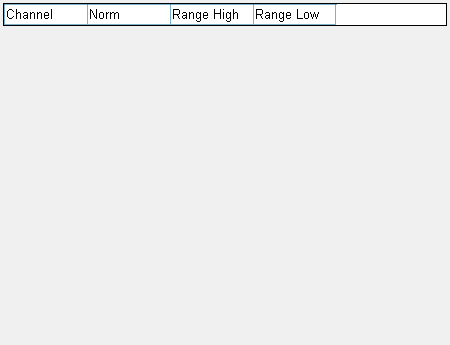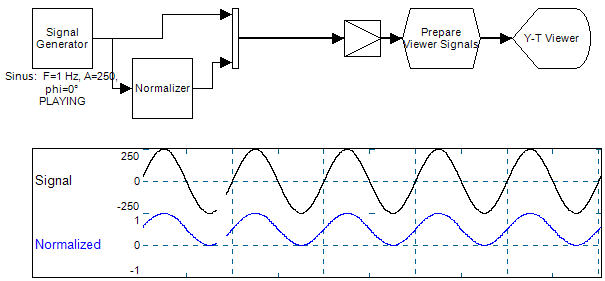 Normalizer
Normalizer
Overview
Use the Normalizer to shift and resize signals in such a way, that they become signals between 0 and a norm value. How much the signals are shifted and resized depends on the settings of the lowest and highest input values.Operator ports
Input S: Floating point valuesOutput S_norm: Floating point values
Properties
Find more information about changing properties here: linkCaption
type: Word or phraseThe name of the object in the project. This name must not contain '.' or '$' characters.
Every object has the Caption property. This property is very important, because it is the name by which Polybench recognizes this object.
It is allowed to give multiple objects the same name, as long as the objects are of the same type. In that case, a reference to this caption includes all the objects with the same caption.
In Polybench, every object can be addressed by an Address specifier, which starts with the dollar sign, for example: $My Page.My Object. 'My Page' would be the Caption of a page, and 'My Object' the Caption of an object on that page.
It is allowed to give multiple objects the same name, as long as the objects are of the same type. In that case, a reference to this caption includes all the objects with the same caption.
In Polybench, every object can be addressed by an Address specifier, which starts with the dollar sign, for example: $My Page.My Object. 'My Page' would be the Caption of a page, and 'My Object' the Caption of an object on that page.
Documentation
type: See descriptionOptional documentation of this object.
It is good practice to write in short notes why you have used this object, and why its properties are set the way they are set. If this object is an operator, the Documentation text is displayed below the operator symbol.
Special dialog to change properties of this object: Settings per channel

Allows to change the normalization settings for each channel that is currently connected at the input. For each channel, the output Norm and the input High and Low range can be specified. You may select multiple rows, to change a setting for all rows at once.
Variable Parameters
Find more information about Variable Parameters here: linkAllRangesHigh
type: Real valueHighest value of the input range for all channels
AllRangesLow
type: Real valueLowest value of the input range for all channels
AllNorms
type: Real valueNorm setting for all channels. The signals are normalized between 0 and Norm.
Details
The Normalizer converts a signal such that it fits between 0 and another value (the norm). The next image illustrates this:
In this example, the original signal has a range between -250 and 250. After the Normalizer, the range is between 0 and 1. For this example, the settings for this channel in the Normalizer are:
Norm = 1
High = 250
Low = -250
If the input signal get a bigger amplitude than the High and Low settings of the Normalizer, then the signal will be trancated. In that case you will see flat tops, so the output will never stretch beyond the Norm value.
The calculation is also performed on constant values (e.g. from a Constant (link)).
Examples
Example: Normalizer Demo
Demonstrates the Normalizer operator.Examples\DF0404124_001_Normalizer_Demo.xmc
